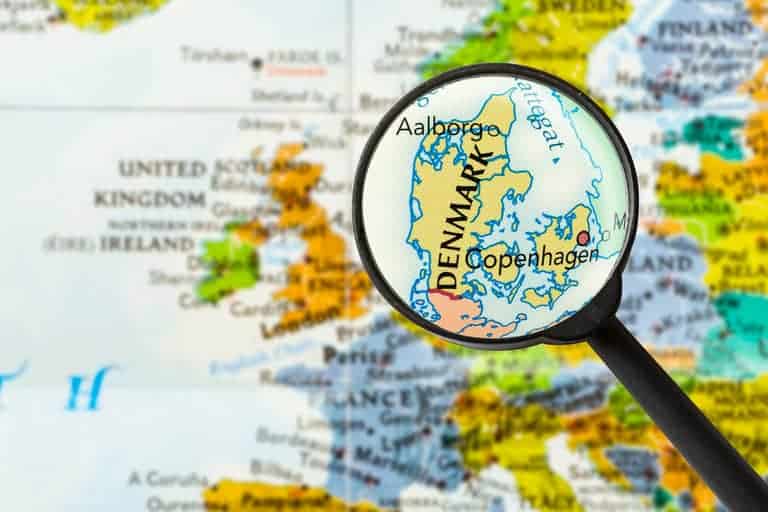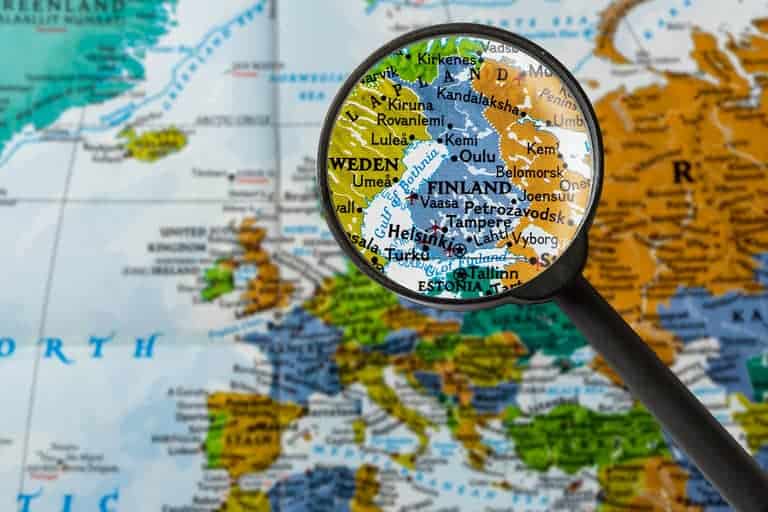The words “Scandinavia” and “Nordic” are sometimes used in relation to each other, and some people even use them as synonyms. This has led many to wonder if Scandinavia is Nordic.
In general, Scandinavia is Nordic, when the word Nordic is used to describe the countries or people of Norway, Sweden, and Denmark.
When the broader use of the name Scandinavia is implied, the word Nordic may also include the countries of Finland, Iceland, and the Faroe Islands.
Often, terms like Scandinavia, Nordic, and Northern Europe often have overlapping meanings in popular usage.
To know whether or not a particular country is implied when one of the terms is used, it may be necessary to know the intent of the speaker or writer.
Surveying the common use of each name reveals mostly overlapping meanings. Keep reading to learn more.
Scandinavia is one of the most fascinating places in the world. See The Scandinavia Peninsula: 16 Facts? to learn more.

Common uses of “Scandinavia” and “Nordic”
What is normal when it comes to how these terms are used?
Scandinavia
The name Scandinavia is used in a narrow sense and in a broader sense.
- In the narrow sense, Scandinavia refers to Norway, Sweden, and Denmark.
- In the broader sense, the name refers to those three countries, as well as Finland, Iceland, and the Faroe Islands.
Sometimes people use the narrow sense of the name to specify certain characteristics of the land, people, or culture of Norway, Sweden, and Denmark.
Likewise, the broader sense can be used to talk about things related to all six northern European countries. There are other reasons for the narrow and broad sense, too.
- Some residents of Norway, Sweden, and Denmark, believe the name Scandinavia should be used only for them, because in certain ways they have a shared history and culture with each other, which is not shared with their regional neighbors.
- Also, some residents of Finland, Iceland, and the Faroe Islands, do not want to be identified as Scandinavia, because in their view it minimizes their own uniqueness and independence to group them with larger countries that have certain dissimilarities.
When the names Scandinavia, Nordic, or other similar terms are used, it is best to determine the intent of the user to be certain of the implications.
Nordic
The word Nordic comes from the German word, Norden, meaning “the north.”
Conventional definitions of the word “Nordic” associate it with the region known as Scandinavia, as the term is used in common English.
When used as a noun, the word Nordic most often refers to the region, person, or thing in northern Europe.
A survey of three dictionary definitions show similar results for the word Nordic:
- Dictionary.com: a member of the Nordic people, especially a Scandinavian. [1] This definition suggests that the terms overlap.
- Merriam-Webster dictionary: a native of northern Europe, (2) a person of Nordic physical type, (3) a member of the peoples of Scandinavia. [2] Taken together, this definition suggests overlapping meaning.
- Cambridge dictionary: belonging to, or relating to, Scandinavia, Finland, or Iceland. [3] In this definition, Scandinavia is being used in the narrow sense, implying Norway, Sweden, and Denmark alone.
In some contexts, Nordic may also refer to Greenland, which today is an independent territory of Denmark. As mentioned previously, it is important to understand user intent in order to determine the meaning of a particular use.
Please note that though Greenland shares more history and culture with northern Europe than with other people groups, the island nation is commonly considered part of the North American continent, not Europe.
Scandinavian countries like Norway, Denmark, and Sweden have a fascinating history. See When was Scandinavia founded? to learn more.
“Nordic”: word history
Stemming from the German and Scandinavian words, the English word Nordic originated in the late 19th century. It came from the French word “nordique” as anthropologists used it, meaning “of or pertaining to the north”:
Nordic: “of or pertaining to the Scandinavian people or their languages or physical type,” 1898, from French nordique (in anthropologist Joseph Deniker’s system of race classifications), literally “of or pertaining to the north,” from nord “north” (a loan-word from Old English; see north).
Perhaps influenced by German Nordisch. As a noun, from 1901. Strictly, the blond peoples who inhabit Scandinavia and the north of Britain. As a type of skiing competition, it is attested by 1949. [4]
“Scandinavia”: word history
With Latin and German roots, the word Scandinavia may have a description of the water that surrounds the countries of northern Europe:
1765, from Late Latin Scandinavia, Skandinovia, a mistake for Scadinavia, from a Germanic source (compare Old English Scedenig, Old Norse Skaney “south end of Sweden”), from Proto-Germanic *skadinaujo “Scadia island,” first element of uncertain origin, second element from *aujo “thing on the water,” from PIE root *akwā- “water” (see aqua-).
It might truly have been an island when the word was formed; the coastlines of the Baltic Sea has changed dramatically since the end of the Ice Ages. [5]

Scandinavian and Nordic language
The majority language in each Scandinavian country is as follows:
- In Sweden it is Swedish
- In Denmark it is Danish
- In Iceland is Icelandic
- In the Faroe Islands is Faroese
These languages come from the North Germanic language family, which is rooted in the Indo-European language base. Scandinavia also includes languages from another language base—Uralic:
- The majority language in Finland is Finnish
- The native Sami people, who live in he northern regions of Norway, Sweden, and Finland, speak a language that goes by the same name
Other words connecting Scandinavia and Nordic
Nordic Bronze Age
The Nordic Bronze Age is a historical period that many consider part of Scandinavian and German history. The period occurred between 1,700-500 B.C.
Nordic-Scandinavian folklore
These terms are often used synonymously to describe various cultural traditions, especially literary ones, common to Norway, Sweden, Denmark, Iceland, and The Faroe Islands.
Examples include trolls, Nattmara, which were female werewolves, and elves.
Nordic sports
Winter sports with the word Nordic in the name have common Scandinavian roots.
For example, the Nordic Combined is a sport that includes cross-country skiing and ski jumping; nordic skiing dictates that the heel of a boot cannot be fastened to the ski; nordic walking uses poles similar to those used in skiing.
Scandinavian is one of the most fascinating regions in the world. See Why is Scandinavia less populated? to learn more.
The “Nordic” region
The word “nordic” as an adjective can be used to describe conditions common to Scandinavian countries, and imply wintry and mountainous conditions.
Nordic countries not only comprise the northernmost nations of the European continent, but they are among the northernmost countries on Earth.
The Arctic Circle extends into the northern regions of Norway, Sweden, and Finland. These areas see less of the sun than most of the Earth and often have harsher winters.
Surrounding seas, such as the Norwegian Sea, the North Sea, and the Arctic Ocean also impact the climate of Scandinavian countries.
The Gulf Stream in the Atlantic Ocean can carry warm air, especially to the western regions, such as the westernmost coast of Norway.
Regions further away from the Gulf Stream, like Sweden and Finland, can experience cooler temperatures.
Facts about winter in Nordic countries:
Denmark: Denmark’s coldest month is February when the mean temperature is 0 °C (32 °F).
Its primary landmass, the Jutland Peninsula, is surrounded by water on three sides, which contributes to the cooler weather.
The number of hours of sunlight per day increases during February when residents get seven to eight hours a day. This is not uncommon for countries so far north.
Iceland: The coasts of Iceland have average January temperatures of about 0 °C (32 °F), while the highlands of central Iceland generally stay below −10 °C (14 °F).
The lowest winter temperatures in Iceland are between −25 °C (−13 °F) and −30 °C (−22 °F).
Norway: In Norway, the coastal regions have mild winters, while further inland, winter is much cooler.
During midwinter, southern areas of Norway only get five to six hours of sunlight a day, while the north gets little to none.
In January, the average temperature in Norway is between −6 °C (21 °F) and 3 °C (37 °F).
Finland: Finland averages −6 °C (21 °F) to 1 °C (34 °F) in the month of January. Finnish areas north of the Arctic Circle rarely see the sunrise, due to the natural phenomenon of the polar night.
In January and February, temperatures in this area can drop to −15 °C (5 °F). In February, Northern Finland sees about four to six hours of daylight a day.
The Faroe Islands: Conditions vary considerably on The Faroe Islands due to ocean weather and land elevation. Some areas get snow and others do not. Average highs in January and February are 5.8 °C (42.4 °F). [6]
References:
[1] Source
[2] Source
[3] Source
[4] Source
[5] Source
[6] Source
